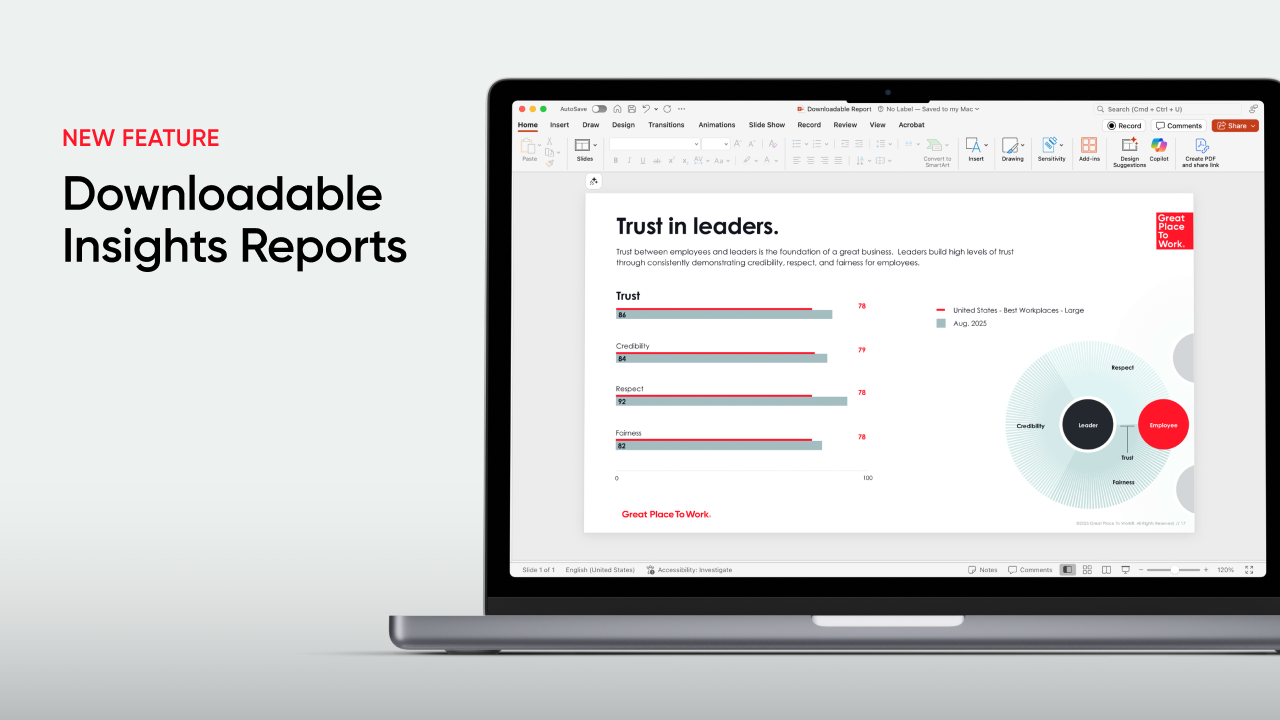Here’s what the data says can help employees generate better ideas and embrace crucial transformation initiatives.
When a company launches a new push to bring employees back to the office, a need to innovate is often one of the reasons for the move.
Starbucks shared this in its letter to employees about bringing everyone back to the office four days a week:
"We are reestablishing our in-office culture because we do our best work when we’re together. We share ideas more effectively, creatively solve hard problems, and move much faster. Being in person also helps us build and strengthen our culture."
Many leaders frame the RTO debate in terms of the ability to tackle complex challenges and respond to disruption.
AT&T’s John Stankey wrote in a memo:
"We run a dynamic, customer-facing business, tackling large-scale, challenging initiatives ... If the requirements dictated by this dynamic do not align to your personal desires, you have every right to find a career opportunity that is suitable to your aspirations and needs."
Nike’s former CEO John Donahue blamed remote work for a lack of innovation that was holding back the sportswear brand: “In hindsight, it turns out, it’s really hard to do bold, disruptive innovation, to develop a boldly disruptive shoe on Zoom,” he told CNBC.
He has since been replaced by Elliot Hill as Nike aims to bounce back from slumping revenues.
Remote work doesn’t determine innovation
Whether a team works together in an office or from remote locations around the world, location isn’t necessarily the reason for lower innovation rates.
Instead, leaders should ask a more important question: “How well do I know my team?”
“Connecting and caring are two important practices before you even try to innovate,” says Andrés Tapia, principal and founder of Andrés Tapia Strategy Group and former senior client partner at Korn Ferry. “If I do not feel psychologically safe, am I going to offer that alternative, non-mainstream idea?”
It’s not enough to bring everyone together in a room for a brainstorming session. What really unlocks innovation is when leaders know the specific backgrounds and strengths of the people on their team and form higher levels of trust.
“I need to understand the cognitive power of my team in the fullness of the word, not just by their title and where they’ve worked before,” Tapia says. “I need to know what their educational or work or lived experience was in the context of the work that they do or work that they’ve done.”
Great Place To Work® research shows the power of trust on innovation rates within a company. At companies with the highest levels of trust, like the Fortune 100 Best Companies to Work For®, innovation rates are higher compared to a typical U.S. workplace.
At the 100 Best, six employees have a lot of meaningful opportunities to innovate for every two employees who don’t have opportunities to innovate. That’s much higher than the typical U.S. workplace, where the ratio of innovating employees to non-innovators is 2:2.
The research shows that lower ratios have a direct impact on revenue. Companies with higher rates of employees engaged in innovation have 5.5 times more revenue growth than their less innovative peers.
The power of human connection
What does matter for innovation is how connected employees feel to each other at work.
“The research clearly tells us if you do not create human connection, we’re going to suboptimize the power of purpose, creativity, and intellectual and emotional contribution,” Tapia says.
“When we say a team has great chemistry, it’s not a metaphor,” Tapia adds. “We now know it is science when our brains get triggered and release endorphins and neurotransmitters that create a greater sense of trust and confidence.”
Great companies intentionally create experiences that build this connection, such as Cisco’s “Proximity Initiative” or Cadence bringing women from across the organization together to work on business solutions.
Employee resource groups can also be unique assets that build the connection needed to generate new ideas.
For leaders who second-guess spending valuable time on team-building activities, Tapia has a couple of pieces of advice: “One, this takes a lot less time than you think it will,” he says. “Two … there’s a return on this investment. If you spend this little bit of time, you’re going to get payoff.”
If innovation is so important for your business — and in the era of AI disruption and rapid market transformation, it really is critical — how can you afford not to make your brainstorming and innovation incubators more effective?
Tips for driving innovation
How can your company drive higher rates of innovation? Great Place To Work analyzed 1.3 million employee surveys and identified four experiences that make a difference:
1. Ensure employees have consistent training and development opportunities
When employees reported having training and development opportunities, they were 87% more likely to say they could participate in innovation at their company.
How do great companies increase opportunities for learning and development? AI tools are increasingly part of the solution, such as ServiceNow’s learning platform “frED” or internal talent marketplaces that connect employees with opportunities and roles across the company.
2. Connect every role to the mission of the organization
Purpose at work — when employees believe their job has special meaning — increases the likelihood that employees can innovate by 64%.
Great companies take the time to connect every employee with the impact of their work. At Jackson Healthcare, the vice president of community impact invites every new hire to a one-on-one coffee chat to hear their story and help new hires find ways to get involved in projects that inspire them.
3. Celebrate people who try new things — even if they fail
To have psychological safety, employees must know that if they take a risk on a new workflow or developing a new product, they won’t be penalized if the project doesn’t succeed. When people don’t feel safe to fail, they will only take on low-risk projects that are assured to succeed.
When employees say that their company celebrates people who try new things, regardless of outcome, they are 53% more likely to innovate.
There are an infinite number of ways to recognize and celebrate employees. Great companies make sure that everyone has an opportunity to be recognized for their hard work.
4. Make sure leaders take time to learn about their team.
When employees say that management cares about their lives outside of work as well as on the job, they are 40% more likely to say they can innovate.
Getting to know your employees starts with listening. World Wide Technology launched a storytelling initiative to get more people sharing their unique stories.
The result? Much higher levels of trust that resulted in a meteoric rise on the Fortune 100 Best list.
Turn culture insights into business wins
Let the Trust Index™ Survey reveal your workplace’s hidden strengths and areas for growth. Start transforming today.








